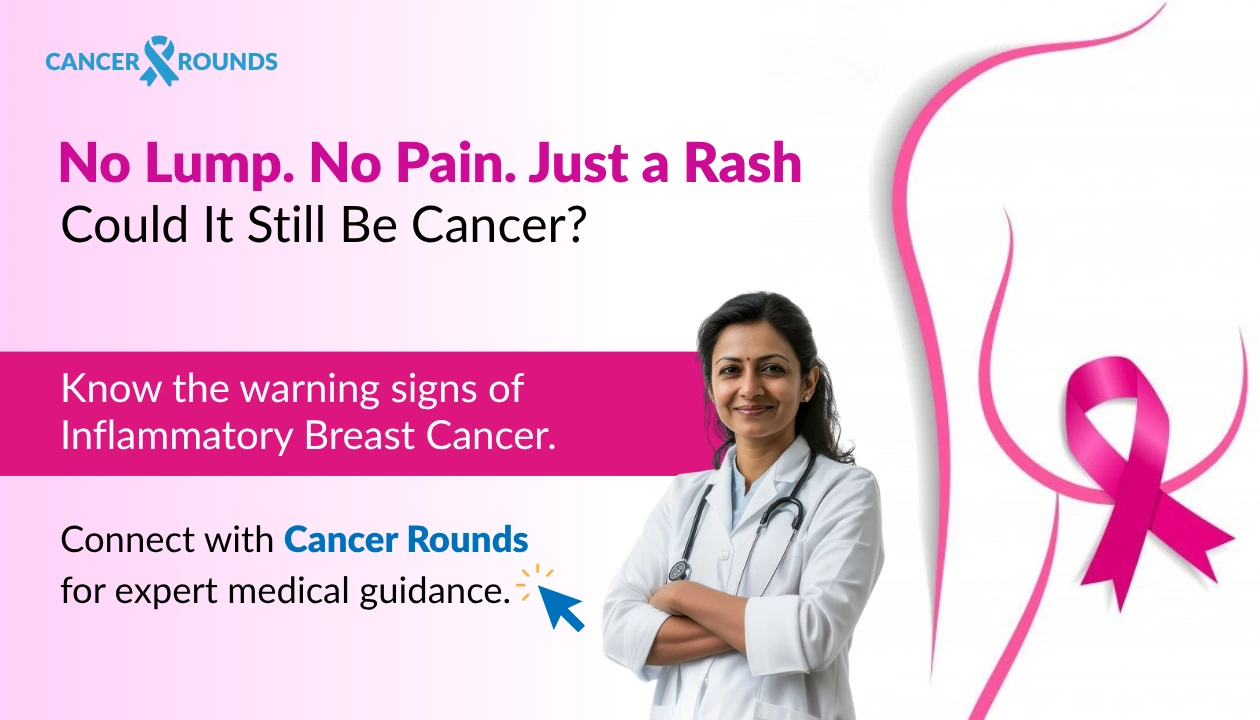When we think of breast cancer, our minds often jump to the idea of a lump. And for good reason – it’s a widely publicised symptom. But what if I told you there’s a rarer, more aggressive form of breast cancer that doesn’t always announce itself with a palpable mass? I’m talking about Inflammatory Breast Cancer (IBC), and one of its most crucial early indicators is a rash.
Now, before you panic every time you spot a slight redness on your chest, let’s take a deep breath. Breast rashes are common and often benign. However, understanding the specific characteristics of an IBC rash or how IBC rash look like, such as pink, red, or even purple skin discoloration; orange peel effect; persistent itching, pain, or tenderness; change in nipple appearance, and swelling and warmth, is vital for early detection and better outcomes. So, let’s delve into what this elusive rash actually looks like, and how to spot the difference.
The Elusive Face of an IBC Rash: More Than Just Redness
What does IBC rash look like and wondering how to identify inflammatory breast cancer? Unlike a typical skin irritation, an inflammatory breast cancer rash isn’t always straightforward. It’s often described as an “inflammatory” appearance, meaning the breast can look infected or inflamed. But the key is that it doesn’t always look the same for everyone, and it can be easily mistaken for other conditions. There is no clear cause of inflammatory breast cancer. Read on to know the inflammatory breast cancer symptoms.
Here’s what makes an early inflammatory breast cancer rash distinctive:
- Speed is Key: This is perhaps the most critical distinguishing factor. Inflammatory breast cancer is notoriously aggressive and can develop with alarming speed. If you notice a marked change in the appearance of your breast skin – redness, swelling, or texture changes – over a few weeks, days, or even hours, this warrants immediate medical attention. It’s not a gradual change like some other rashes.
- Widespread Discoloration: While some women describe the rash as starting small, even like a bug bite, it often progresses to involve a significant portion of the breast. We’re talking about at least one-third of the breast, sometimes covering the entire area. The skin discoloration can be pink, red, or even purple, depending on your skin tone. On darker skin, it might appear more dark or purplish rather than bright red.
- The “Orange Peel” Effect (Peau d’Orange): This is a hallmark sign, though it might not be present in the very earliest stages. The skin can become thickened, pitted, or dimpled, resembling the skin of an orange. This is due to the cancer cells blocking the lymphatic vessels in the breast skin, causing fluid buildup and swelling. Imagine pushing your finger into an orange peel – that slightly uneven, dimpled texture is what we’re talking about.
- Swelling and Warmth: The affected breast may feel noticeably swollen or firm, and often feels warmer to the touch than the other breast. This warmth or burning sensation is another direct result of the lymphatic blockage and inflammation.
- Persistent Itching, Pain, or Tenderness: While many benign rashes can be itchy, the itching associated with IBC can be persistent and accompanied by pain or tenderness in the breast. It’s not just a minor irritation that comes and goes.
- Nipple Changes: Keep an eye out for nipple changes, such as the nipple becoming inverted (turning inward), flattened, or dimpling.
Inflammatory Breast Cancer vs. Other Rashes: The Tricky Part
This is where it gets challenging. The symptoms of IBC can mimic several more common and less serious conditions. Here are the main culprits it’s often confused with:
5 easy Steps to Get Treated Abroad

Share Case Details

Get Expert Opinion and Hospital Quotes

Get Visa Invitation & Hotel Recommendations

Get Received At Airport and Start Your Treatment

Travel Back and Get Followups Through Us
- Mastitis: This is a breast infection, most common in breastfeeding women. Symptoms like breast pain, swelling, redness, and even flu-like symptoms can overlap with IBC. Healthcare providers often initially treat suspected mastitis with antibiotics. The crucial difference? If your symptoms don’t improve significantly after a week of antibiotics, it’s essential to push for further investigation.
- Nipple Dermatitis (Eczema): This can cause dry, itchy, red, or brown patches on or around the nipple. If you have eczema elsewhere on your body, it might be a familiar sight. However, IBC tends to be more widespread and rapidly changing than typical eczema.
- Breast Skin Dermatitis: This is an allergic reaction to things like soaps, detergents, or fabrics. It usually clears up once the irritant is removed. Again, the rapid progression and widespread nature of IBC are distinguishing features.
- Paget’s Disease of the Breast: This is another rare type of breast cancer that affects the nipple and areola, causing itching, redness, and scaling. While it can resemble eczema, a biopsy is needed to differentiate it.
- Breast Abscessess: It is a collection of pus in the breast, usually caused by bacteria and is characterised by hot, swollen, red mass on the breast and may cause nausea, fever and chills.

Why Early Detection Matters So Much for IBC
Inflammatory breast cancer is notoriously aggressive. It’s always considered at least stage III at diagnosis because it involves the skin. The fact that it doesn’t usually form a lump makes it harder to detect through routine mammograms or self-exams. It can be a sign of breast cancer without a lump. This is why being vigilant about skin changes is absolutely paramount. Inflammatory breast cancer is seen more common in women under the age of 40, Black women, and women with higher body mass index (BMI). Medically, mammogram, skin punch biopsy, MRI or ultrasound is recommended for IBC rash diagnosis.
When the lymphatic vessels get blocked by cancer cells, it’s like a drainage system backing up. This leads to the characteristic swelling, redness, and inflammation that gives IBC its name. Despite the “inflammatory” label, it’s not caused by inflammation itself, but rather the appearance of inflammation due to the cancer cells, hence refers to the inflamed appearance of the breasts.
What to Do If You Notice a Rash on Your Breast
If you observe any of the following, it’s time to act swiftly:
- Rapid Changes: If a rash or other skin changes on your breast appear suddenly and worsen quickly (within days or weeks).
- Persistent Symptoms: If the rash, swelling, warmth, or pain doesn’t improve within a couple of days, or after a short course of antibiotics (if prescribed for suspected infection). Hence, it is highly crucial to know the difference in breast cancer rash vs infection.
- Widespread Nature: If the discoloration or rash covers a significant portion of your breast.
- Orange Peel Appearance (Peau d’Orange breast rash): Any dimpling or thickening of the skin.
- Nipple Changes: A newly inverted, flattened, or dimpling nipple.
Don’t self-diagnose. Always consult a healthcare professional immediately. While it’s likely to be something benign, it’s always better to rule out inflammatory breast cancer. Be persistent if you feel your concerns aren’t being fully addressed. Sometimes, doctors may not consider IBC skin changes at first due to its rarity, so bringing your concerns and advocating for yourself is crucial.
Advances in Diagnosis
There’s hope on the horizon! Researchers are actively working on tools to aid in earlier IBC diagnosis and early signs of inflammatory breast cancer. This includes algorithms to help patients advocate for additional imaging (MRI, ultrasound) or a breast biopsy, and even an app using artificial intelligence (AI) to compare photos of breast rashes to known cases of IBC. These innovations aim to empower both patients and doctors to make faster, more accurate diagnoses.
The Takeaway
An early inflammatory breast cancer rash is not your typical rash. It’s often characterized by rapid changes, widespread discoloration (red, pink, or purple), swelling, warmth, and sometimes a distinctive “orange peel” texture. Trust your instincts. If something feels significantly different or is changing quickly, seek medical advice without delay. Early detection is the most powerful tool we have against these aggressive breast cancer signs and disease. Your breasts deserve your attention, and understanding these subtle but critical signs can truly make a difference.
 Chat on WhatsApp
Chat on WhatsApp












